
| HARDEEVILLE, SC:
Talk about talking non-stop! Savannah National Wildlife
Refuge is telling its unique story to visitors all day
long on its wildlife drive’s new “Audio Tour” through
the use of five low-power radio stations. Each station
describes for visitors what they are seeing – and in
some cases what they can’t see – as they look out their
car windows at key locations in the Refuge. According to volunteer engineer Arnie Weisbrot, using radio for interpretation is not a new idea when considered against competing technologies that use smartphones or special audio players to perform similar tasks. But the staff at Savannah NWR chose to use the radio method because of the universal presence of radio receivers in automobiles and because of radio’s ability to “spread interpretive information to a wider audience.” States Weisbrot, “Potential users are familiar with this type of system…thus making public acceptability and experience levels very high.” Systems that provide aural interpretation are also popular because they allow visitors with impairments to experience historic sites and natural areas in a comfortable, convenient environment. What makes Savannah NWR’s System unique?
|
| Case Study by Arnie Weisbrot, Volunteer Engineer Savannah NWR |
| How can you
provide interpretive information to visitors who drive
along a four mile wildlife drive? Many techniques are possible, ranging from manned interpretive stations, to extensive signage, to GPS-based location-aware recordings, to cell phone QR codes, to rented hand-held audio players, to radio broadcast systems. All of these have various advantages, but Savannah NWR has selected a very low power AM radio system to spread interpretive information to a wider audience. Savannah NWR is fortunate to have significant visitation of about 200,000 persons annually along the four mile Laurel Hill Wildlife Drive. Almost all visitors drive a vehicle and almost all the vehicles have an AM radio receiver. The choice of an optimum system was simple – broadcast audio to the vehicles using several very low power transmitters strategically located along the wildlife drive. On top of that, Savannah NWR was fortunate to have the services of a volunteer electronic engineer, Arnie Weisbrot. Arnie designed, acquired, installed, and activated a five-transmitter system [InfOspot] manufactured by Information Station Specialists. Most potential users are familiar with this type of system. The blue signs are visible along many highways, “Tune to 1610 AM for Information,” thus making public acceptability and experience levels very high. In this case, the transmitter is a very low power device that does not require a license from the Federal Communications Commission, though in this federal government installation, the National Telecommunications and Information Administration granted permission to use 1610 kHz. The range of these transmitters is typically less than one-quarter mile, and they are delivered from Information Station Specialists as a complete system, from audio source to antenna, including cabling. The only remaining task was mounting the units. Well, not quite. The first real action was selecting appropriate locations. The stations had to be separated enough so that they did not mutually interfere. They needed to be close to spots where good interpretive information was appropriate. They needed to be relatively secure from potential vandalism or damage. They needed a source of power. At two locations, commercial AC power was available but the other three locations were remote with no power available. Consequently, three solar power supplies were designed and procured so that the systems will operate during daylight hours while the wildlife drive is open. The solar power supplies came from Solar Electric Supply. The solar powered locations must be in full sun for maximum power gain. The spots had to be easily accessible for installation and maintenance. After considerable design discussion, five suitable spots were selected. |
| Photos
Courtesy of Savannah National Wildlife Refuge |
|
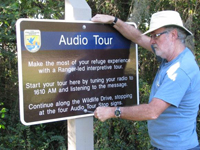 |
|
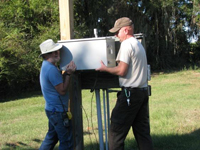 |
 Click to view map. |
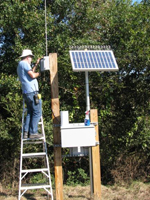 |
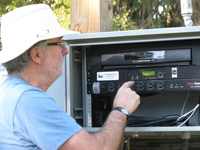 |
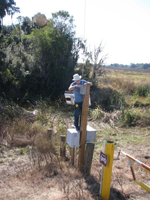 |
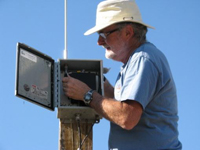 |
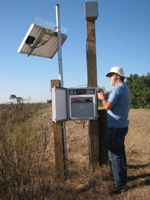 |
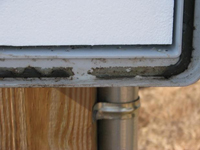 |
Even after assembly of all the components, quite a bit of optimization was needed. Most important, the range of each transmitter must be maximized while also minimizing signal interference between nearby transmitters. The transmitter antenna systems must be tuned to generate the best signal. Audio levels can be adjusted to provide clear, undistorted reception with strong signal levels in visitor vehicles. Even the solar panel orientation must be optimized to collect maximum power at all times of the year. Needless to say, the installation and optimization effort generated many trips around the wildlife drive. After a week of testing, the entire five-transmitter system was declared ready for real interpretive use.
Monica Harris, the Savannah NWR Visitor Services Manager created the interpretive scripts with consultation and assistance of many other specialists. Each script is about two minutes long, enough to contain valuable interpretive information, but not so long that visitors would be bored. The presentations cover a wide range of information. Some rules and guidelines are briefly presented at the entrance station, but the essence of the message is welcome to the drive. The next stop tells about the history of the local area, including a brief song that slaves might have sung while working in the rice fields about 160 years ago. The third stop describes the wildlife that might be around. The audio includes some bird calls and the sound of an alligator bellowing. Continuing farther around the drive, the visitor travels along a canal carrying fresh water to the refuge. The audio transmitted at that spot describes the canal and the need for fresh water resulting from harbor deepening and salt water intrusion. The final stop at the exit from the drive summarizes the visitor experience and provides directions to other refuge attractions like the nearby visitor center. After several iterations to get the scripts just right, the audio was recorded professionally by Bill Baker of Information Station Specialists. Hear example. Finally, signage at each audio tour location was installed, and the system became operational.
In six months of operation, we have had some growing pains. A very long period of cloudy rainy weather in the summer totally depleted the solar-powered batteries. The fix is to turn off the transmitters for a couple of days to let the solar charging system catch up. Some of the enclosures have had water intrusion problems, primarily due to inadequate cable entry seals. The fix is to replace the manufacturer-applied caulking with high quality exterior grade cable entry sealant. One of the transmitters gives very poor coverage because the antenna is not sited well. The fix is to relocate the antenna mounting, or possibly the entire transmitter system. Finally, the most unusual problem has been invasion by ants! Several of the enclosures have been damaged by ants, probably Acrobat Ant (Crematogaster spp). The ants have possibly eaten some of the gasket material, or perhaps the formic acid excreted by the ants dissolved the gaskets. This problem has been very interesting to track down. Even the application engineers at the manufacturers were very surprised by the ant attack. The fix is to completely seal all cable entry points, apply tanglefoot around the mounting posts, and replace the damaged parts.
The Interpretive Radio System at Savannah NWR is now operating effectively to give visitors another source of interpretive information. The total cost of the system was within reason, made more acceptable by significant volunteer labor. The procurement and installation activities were fairly straightforward by a competent technical resource. At the moment, Savannah NWR is quite pleased with this transmitter system. The next step is to seek feedback from visitors about the Interpretive Radio System and possibly alter the setup or audio to optimize use.
PO Box 51, Zeeland, Michigan, USA, 49464-0051, Phone 616.772.2300, Email
• • •